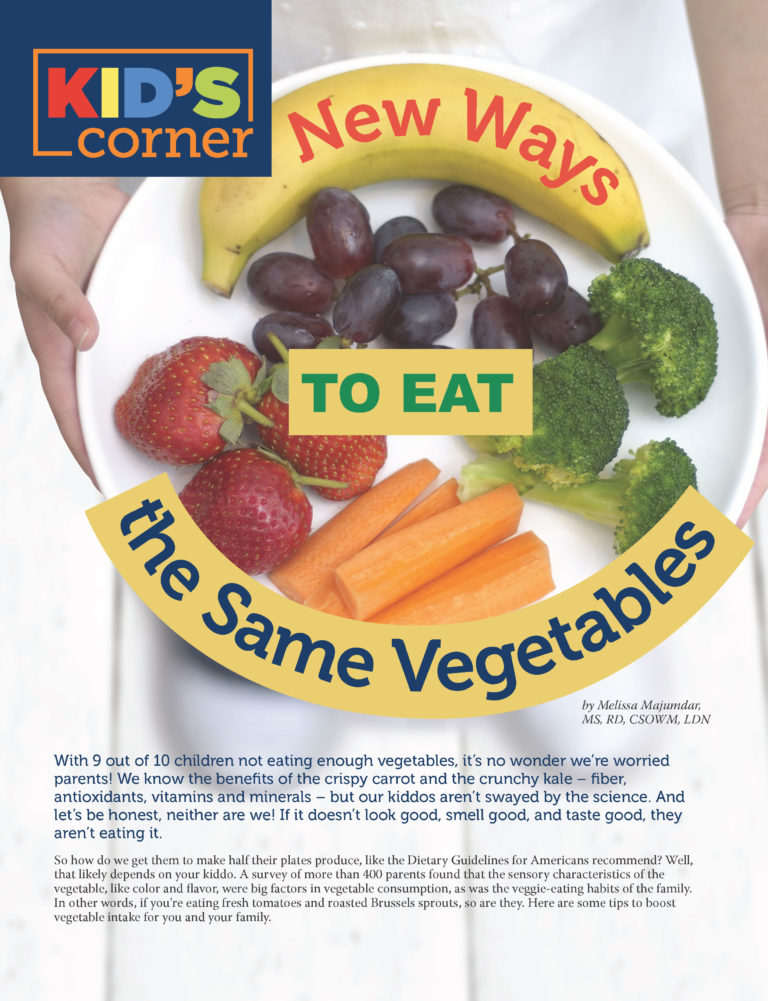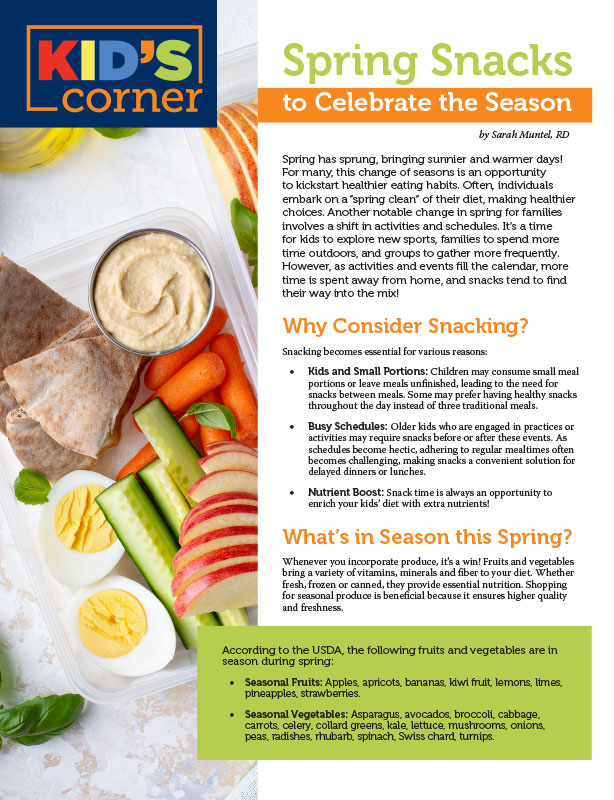Kid’s Corner: New Ways to Eat the Same Vegetables


by Melissa Majumdar, MS, RD, CSOWM, LDN
Fall 2021
With 9 out of 10 children not eating enough vegetables, it’s no wonder we’re worried parents! We know the benefits of the crispy carrot and the crunchy kale – fiber, antioxidants, vitamins and minerals – but our kiddos aren’t swayed by the science. And let’s be honest, neither are we! If it doesn’t look good, smell good, and taste good, they aren’t eating it.
So how do we get them to make half their plates produce, like the Dietary Guidelines for Americans recommend? Well, that likely depends on your kiddo. A survey of more than 400 parents found that the sensory characteristics of the vegetable, like color and flavor, were big factors in vegetable consumption, as was the veggie-eating habits of the family. In other words, if you’re eating fresh tomatoes and roasted Brussels sprouts, so are they. Here are some tips to boost vegetable intake for you and your family.
Have Your Child Shop with You
Engaging children at the store is the first step in vegetable-eating success.
- Compete to find the brightest strawberry or the cutest apple. Bonus points for eating the scavenger hunt finds!
- Have each member of the family pick out their produce for the week. This will give everyone an opportunity to get something they like and try something new.
- Try something different. Farmer’s market finds or multicultural grocery stores are great places to seek out new produce. Red okra and green papaya were surprise likes in our house.
Put the Kids in Charge
Power is powerful, so put your kids in the driver’s seat when it comes to vegetables.
- Get their help with washing, peeling, chopping and serving the vegetables. If at the end of the day they still don’t try or eat much of the vegetables, they will at least know how to prepare them!
- Keep special kitchen tools for the kids. Having a kid-friendly knife, vegetable peeler or cutting board they can call their own brings them closer to the kitchen.
- Spice things up, kiddo-style. Let your kids choose and sprinkle the oil and seasoning. Go simple with salt and pepper, pre-measuring and letting them pour over the veggies. You can also let them create their own spice blend with different amounts of oregano, basil, garlic powder, onion powder or my kids’ favorite: everything bagel seasoning.
- Make the sauce. While you’re dicing and slicing, set the kids up with an array of fresh herbs, oils, vinegar, garlic, onion, plain yogurt, and seasonings to construct the salad dressing or finishing sauce for the vegetables.
Sample the Rainbow
These days, we can taste the rainbow in the produce aisle!
- Branch out from a tried-and-true veggie by switching up the color. Getting kids used to new colors is a big step and could get them one degree closer to a brand-new vegetable. For example, orange carrot [ yellow carrot (win!) [ yellow pepper (score!).
- Run a taste test to see which color veggie, or shape, is the favorite. Tomatoes, carrots, cauliflower, beets and potatoes are great for this and can often be purchased in a multicolor pack. For shape ideas, try veggie coins, strips, zoodles (zucchini noodles, but you can replicate with other veggies) or cookie-cut shapes.
- Rate the veggies using a homemade scorecard. Have the kids create their own categories or go off of taste, texture, sweetness, crunch, etc. In order to rate, use stoplight colors or a simple scale of 1-5.
- Serve a holiday-themed or color-themed plate. Staying on-theme may inspire your little ones to try red peppers for Valentine’s Day or broccoli on St. Patrick’s Day. Keep expectations and quantities low to avoid food waste and disappointment.
Timing is key
Children are more likely to eat vegetables when they’re hungry, so capitalize on this!
- When dinner is running late, pull out a veggie tray with dip options. Hummus and yogurt-based dressings are a great way to dress up a vegetable and keep them snacking on something healthy before the main dish comes out.
- Set the oven to preheat for when you’re scheduled to be home in the evening. Pop in some veggies and serve those as the rest of dinner is being plated. While rare, my kids have wiped out the roasted cauliflower before we were all sitting.
- Keep a drawer or bin with cut-up veggies for easy access. It’s okay if they pass on the produce, but they will hopefully have more room for veggies at the next meal.
Roasted Broccoli with Soy Sauce
Adapted from KaylynsKitchen.com
Ingredients:
- 1 lb. fresh broccoli florets
- 1 ½ tbsp. olive oil
- 1 Tbsp. soy sauce
- 1 tsp. sesame oil
- 1 Tbsp. sesame seeds, toasted
Directions:
- Preheat oven to 450º F.
- Cut broccoli into pieces about 2 inches long. Then cut the stems to where the florets start and break apart so broccoli is in same-sized pieces.
- Whisk together the olive oil, soy sauce and sesame oil.
- Place broccoli in plastic mixing bowl and toss the above mixture in with it.
- Arrange the broccoli in a single layer on the baking sheet. Roast for 10 minutes.
- After 10 minutes, stir or turn the broccoli over and then continue roasting for 5 more minutes until the broccoli is tender-crisp.
- While the broccoli roasts, toast the sesame seeds in a dry pan over very high heat for 30-60 seconds.
- When the broccoli is done, arrange on serving dishes and sprinkle with sesame seeds.
Serve More, Eat More
Serving a variety of anything increases the chances, and the quantity, that we eat. While not the goal at a buffet, this is a positive on the salad plate!
- At dinner, serve a cooked vegetable and a raw vegetable. Everyone has a choice or they can do both, increasing the chance of a win.
- Serve a salad, but consider a serve-yourself or salad bar style. My son much prefers a deconstructed salad, without dressing, over foods being mixed together. A smaller sample-sized cup, the kind condiments are served in, is a great place to start.
- If food is served family-style, kids are empowered to be mindful about the amount and type of food they choose. Ellyn Satter (EllynSatterInstitute.org) has lots to say about feeding children and the Satter Division of Responsibility in Feeding. In short, adults choose the what, when and where of feeding and the child chooses how much or whether to eat.
- Offering veggie options alongside foods they are very comfortable with can feel safer to kids. Some feel more comfortable with the food on a separate bowl or plate, so perhaps try muffin tin meals with almost no chance of vegetable contamination!
Remember, Exposure is Key!
Vegetable pickiness is common and widespread, but you too can prevail. A food exposure is an experience with a food and could be in the form of touching, smelling, licking, or even allowing a food on the plate. Repeated exposures are necessary to increase vegetable intake, so take it slow and count every win. Studies show it takes most kids at least 8-10 days in a row of tasting a vegetable to increase acceptability. Pressure is not helpful, but leading by example is, so fill that plate with goodies from the garden and have some on the side too!
About the Author
Melissa Majumdar, MS, RD, CSOWM, LDN, is the bariatric coordinator at Emory University Hospital Midtown in Atlanta, GA. She has been helping adults and children eat more vegetables for the last 14 years. She has also been helping to prepare adults for bariatric surgery. She serves as an Academy of Nutrition and Dietetics national media spokesperson and spends her free time running and kayaking with her family.
by Sarah Muntel, RD Spring 2024 Spring has sprung, bringing sunnier and warmer days! For many, this…
Read Articleby Robyn Pashby, PhD Winter 2024 “No one is ever going to date you if you don’t…
Read Articleby Michelle “Shelly” Vicari Winter 2024 Winter has arrived! Don’t allow the chilly and damp weather to…
Read Article








